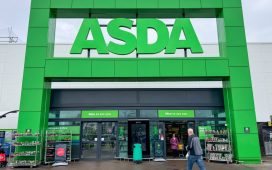The business prospects of Ted Baker have been in turmoil since 2019 when the company’s founder, Ray Kelvin, resigned after allegations of “forced hugging”, and by March this year its UK arm had entered administration.
However, from a fashion perspective, the writing had been on the wall for much longer. The announcement at the weekend that the brand’s remaining 31 stores will close, putting 500 jobs at risk, will leave most in the industry compelled to do little more than shrug. In many ways, it is a surprise it held on this long.
Ted Baker had what could be described as a “moment” in the early 00s. It became known for bodycon dresses that were as good as synonymous with wedding guest outfits; for office-ready blazers; for branded T-shirts and hoodies that were popular with teenagers; and plastic bags that were the tote of choice for many young professionals lugging heels to change into in the office.
The company, founded in Glasgow in 1988, was originally a menswear brand, and has at times also done well for its men’s occasionwear – three-piece suits and zany patterned or floral shirts flew at a time when metrosexuality was an in-vogue term and sartorial ideal. Even when such items were no long “fashionable” they were still the kind of fun uncle wedding gear seen up and down the country.
But even before Kelvin’s resignation in 2019, Ted Baker’s fashion had fallen out of public favour, exacerbated by the rise in other stylish brands all catering for a similar crowd – and its inability to keep pace in terms of design and price.
In the years since, competition has grown only fiercer and the climate on the UK high street more hostile. Rivalry with other middle-market brands competing for shoppers’ hard-earned cash has been ferocious, thanks to the likes of Me+Em, Rixo and Kitri, as well as the continued onslaught of chic Scandi brands such as & Other Stories, Arket, Cos and the more expensive Ganni.
Even the resurgence in interest for many of the brands and looks that were popular during the 00s – such as Gap, Miss Sixty, velour and low-slung jeans – hasn’t helped.
Part of the problem is that Ted Baker hasn’t moved on. In an era of hyper-fast fashion, where consumers can buy into new trends in the bat of an eyelid at very low cost, Ted Baker’s dedication to its staid aesthetic read like an admission of defeat long before its actual demise. Plus, with Depop and Vinted offering many 00s-era designs secondhand, more cheaply and more sustainably, customers would need a special reason to buy from the brand.
after newsletter promotion
Design-wise it has also felt stuck. The rigid plastic flip-flops with bows that were once a popular Ted Baker item could, by many measures, be very 2024 – flat, with coquettecore leanings. Yet somehow they feel like the wrong kind of retro and not the right kind of relevant.
The pandemic and immediate post-pandemic mood for casualwear – elevated loungewear and sports-inspired clothes – has done the brand, thought of as on the smart side of smart-casual, no favours. And the boomerang back to smarter styles still leaves Ted Baker feeling wrong: its tailoring and officewear is no match for the more fashion-forward cuts of the Scandi brands, for instance.
“I tried to make him aspirational,” Kelvin once said of the fictional, archetypal fashion-forward British man who gave the brand its name. But many of the products were hard to differentiate from similar offerings by cheaper brands. Ted Baker tried to present itself as smart and sophisticated, young and fun. The identity felt confused and the clothes felt expensive – and old fashioned.









